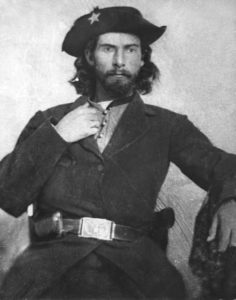Information and Articles About Bloody Bill Anderson, a Civil War General during the American Civil War
 Bloody Bill Anderson Facts
Bloody Bill Anderson Facts
Born
1839 Hopkins County, Kentucky
Died
October 26, 1864 Albany, Missouri
Nickname
“Bloody Bill Anderson”
Rank
Captain
Battles Fought
Battle of Fort Blair
Lawrence Massacre
Centralia Massacre
Orrick, Missouri
Unit
Quantrill’s Raiders
Bloody Bill Anderson Articles
Explore articles from the HistoryNet archives about Bloody Bill Anderson
» See all Bloody Bill Anderson Articles
Bloody Bill Anderson summary: William T. Anderson was born in 1839 to William C. Anderson and Martha Anderson, who bore six children. It was said that as a child he was well behaved. Though he claimed Missouri as his native state, his place of birth is uncertain but likely it was Kentucky. During the 1850s, the Andersons moved to Kansas where his family was respected and by 1860 Anderson co-owned a 320 acre property. His mother was struck by lightning in June 1860 and subsequently died.
Quantrill’s Raiders
Anderson soon turned to trafficking in stolen horses along the Santa Fe Trail, robbing and looting. His father was killed in 1862 in a dispute with Judge Arthur Baker, a former family friend. Bill and Jim Anderson, along with two others, retaliated by killing Baker. Bill Anderson soon became a Confederate guerrilla with Quantrill’s Raiders, the most prominent and feared Confederate guerrilla group in the Kansas–Missouri area. After a skirmish with a US marshal and posse, the Raiders split into small groups. Anderson set up his own guerrilla group which included the infamous Jesse James.
Anderson’s and Quantrill’s guerrilla bands were sometimes in disagreement, but generally they were allies. Three of Anderson’s sisters were captured with other women by a Union commander, General Thomas Ewing, and locked in a temporary jail. The building collapsed, killing several women, including one of Anderson’s sisters. “Bloody Bill” soon gained a reputation for his bloodthirsty tortures and killings, though he did spare and protect women. He would scalp Union soldiers, proudly decorating his horse with the bloody scalps. At times, he had dead enemies decapitated, placing the heads with different bodies.
Bloody Bill’s Death
Anderson’s violent pillages, attacks, and murders came to an end at Albany, Missouri, on October 26th, 1864—one month after he carried out a systemic massacre at Centralia, Missouri, on September 27 of 22 unarmed Union troops who had been on their way home on furlough. After mutilating the bodies, he and his men set up an ambush and wiped out 150 soldiers sent in pursuit of them and viciously mutilated those bodies as well.
In a fight at Albany with the 33rd Infantry Regiment, Missouri State Militia, under Lieutenant Colonel Samuel P. Cox, Anderson was shot in the head, killing him instantly. His blood-soaked body was put on public display at a local courthouse. Anderson was known to keep a rope with 53 knots; each knot represented each killing he had made.
Articles Featuring Bloody Bill Anderson From HistoryNet Magazines
[cat totalposts=’21’ category=’1278′ excerpt=’true’ order=’desc’ orderby=’post_date’]
